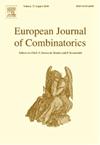2边彩色二部图划分为单色圈
IF 0.9
3区 数学
Q1 MATHEMATICS
引用次数: 0
摘要
给定图G的边的r边着色,当存在p个顶点不相交的单色环的集合覆盖G的所有顶点时,我们说它可以划分为p个单色环。在这个问题的文献中,一条边和一个顶点都算作一个环。我们证明了对于完全平衡二部图Kn,n的每条边的2着色,它可以被划分为最多4个单色环。1970年,Gyárfás和Lehel首次对完全图研究了这类问题,1983年,他们研究了Kn,n。2014年,Pokrovskiy证明了对于所有n,给定其任意两种颜色的边,Kn,n可以划分为最多3条单色路径。事实证明,寻找单色环而不是路径是一个很自然的问题,这个问题在其他图中也被提出过。2015年,Schaudt和Stein证明,对于足够大的2边彩色Kn,n, 14个环是足够的。本文章由计算机程序翻译,如有差异,请以英文原文为准。
Partitioning 2-edge-coloured bipartite graphs into monochromatic cycles
Given an -edge-colouring of the edges of a graph , we say that it can be partitioned into monochromatic cycles when there exists a set of vertex-disjoint monochromatic cycles covering all the vertices of . In the literature of this problem, an edge and a single vertex both count as a cycle.
We show that for every 2-colouring of the edges of a complete balanced bipartite graph, , it can be partitioned into at most 4 monochromatic cycles. This type of question was first studied in 1970 for complete graphs and in 1983, by Gyárfás and Lehel, for . In 2014, Pokrovskiy, showed for all that given any 2-colouring of its edges, can be partitioned into at most three monochromatic paths. It turns out that finding monochromatic cycles instead of paths is a natural question that has also been raised for other graphs. In 2015, Schaudt and Stein showed that 14 cycles are sufficient for sufficiently large 2-edge-coloured .
求助全文
通过发布文献求助,成功后即可免费获取论文全文。
去求助
来源期刊
CiteScore
2.10
自引率
10.00%
发文量
124
审稿时长
4-8 weeks
期刊介绍:
The European Journal of Combinatorics is a high standard, international, bimonthly journal of pure mathematics, specializing in theories arising from combinatorial problems. The journal is primarily open to papers dealing with mathematical structures within combinatorics and/or establishing direct links between combinatorics and other branches of mathematics and the theories of computing. The journal includes full-length research papers on important topics.

 求助内容:
求助内容: 应助结果提醒方式:
应助结果提醒方式:


